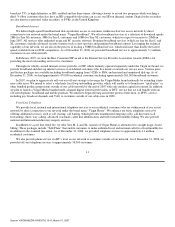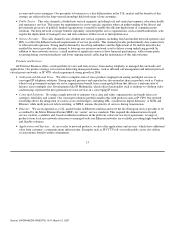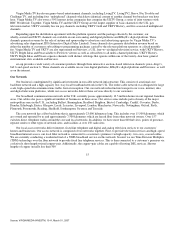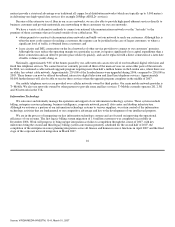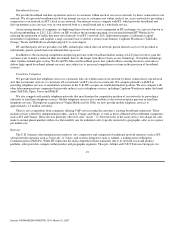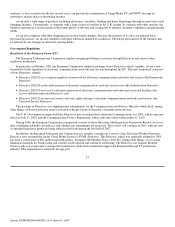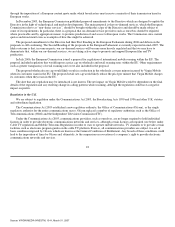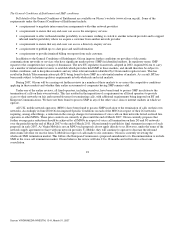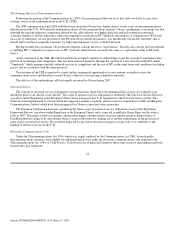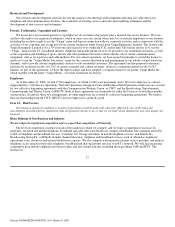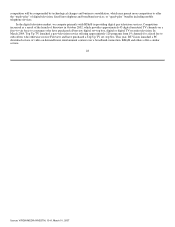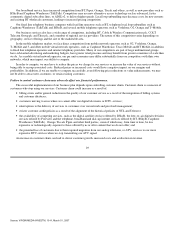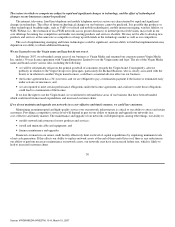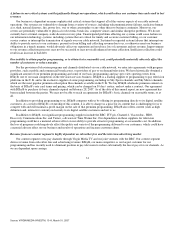Virgin Media 2006 Annual Report Download - page 25
Download and view the complete annual report
Please find page 25 of the 2006 Virgin Media annual report below. You can navigate through the pages in the report by either clicking on the pages listed below, or by using the keyword search tool below to find specific information within the annual report.
audience, as has occurred over the last several years, can provide the continuation of Virgin Media TV and UKTV leverage in
growing its market share of advertising revenue.
sit−up sells a wide range of products, including electronics, jewellery, clothing and home furnishings through its innovative retail
shopping channels. Consequently, it competes with a large variety of retailers in the U.K. market. In common with other retailers, the
business experiences a seasonal peak in the fourth quarter of the year and is impacted by general consumer confidence and purchasing
trends.
sit−up also competes with other shopping and auction−based channels. Because the majority of its sales are initiated from
television broadcasts, sit−up also competes with other television channels for audiences. The future performance of the business may
be affected by any changes in television viewing habits.
Government Regulation
Regulation in the European Union (EU)
The European Parliament and Commission regulate our principal business activities through Directives and various other
regulatory instruments.
In particular, in February 2002, the European Commission adopted a package of new Directives which, together, set out a new
framework for the regulation of electronic communications networks and services throughout the EU. This new framework consisted
of four Directives, namely:
• Directive 2002/21 on a common regulatory framework for electronic communications networks and services (the Framework
Directive);
• Directive 2002/20 on the authorization of electronic communications networks and services (the Authorization Directive);
• Directive 2002/19 on access to and interconnection of electronic communications networks and associated facilities (the
Access and Interconnection Directive); and
• Directive 2002/22 on universal service and users rights relating to electronic communications networks and services (the
Universal Service Directive).
This package of Directives was supplemented, subsequently, by the Communications and Privacy Directive which dealt, among
other things, with data protection issues in relation to the provision of electronic communications services.
The U.K. Government incorporated these Directives into its national laws under the Communications Act 2003, which came into
effect on July 25, 2003, and the Communications Privacy Regulations, which came into effect on December 11, 2003.
During 2006, the European Commission commenced a review of these Directives (the Regulatory Framework Review) to assess
their continuing suitability and efficacy and whether any amendments are necessary. This review will continue in 2007, with any new
or amended legislative proposals being tabled in draft form during the first half of 2007.
In addition, the European Parliament and Commission are currently carrying out a review of the Television Without Frontiers
Directive, now renamed the Audio Visual Media Services (AVMS) Directive. This Directive, which was originally adopted in 1989,
has been a cornerstone of EU audiovisual media policy. It requires the Member States of the EU, among other things, to set certain
minimum standards for broadcasting and controls on the amount and content of advertising. The Directive also requires Member
States to take active measures to ensure that broadcasters under their jurisdiction support the European film and TV production
industry. This requirement is achieved, in large part,
21
Source: VIRGIN MEDIA INVESTM, 10−K, March 01, 2007


